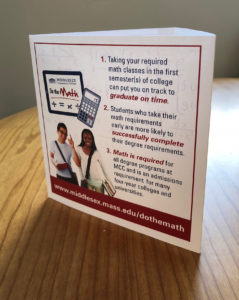It’s a well-known fact that most college enrollments are shrinking all around the country. Due in part to a decade-long stagnation in the number of high school graduates, more and more colleges and universities are focusing on retaining their current students through graduation.
Today, many in-house marketing departments are being asked to not only recruit new students, but also create campaigns that boost student persistence and retention, increase program completion, as well as improve graduation rates.
This is no small task, but certainly an important one. Promoting prompt completion and graduation initiatives can not only keep students on track to finish their degree, but also reduce the amount of money they may need to borrow to finance their education.
It makes sense to utilize your marketing/public relations offices in this endeavor. These professionals are often already in charge of many key communication tools needed to reach current students, including internal advertising channels, social media, mobile app notifications, print materials and the web. Your creative marketing teams are adept at synthesizing often-convoluted processes and academic jargon. Turning this “inside baseball” lingo into more palatable sound bites and key bullet points, can drive student traffic to your website for a deeper dive.
Six key lessons
At Middlesex Community College in Massachusetts, student success is our top priority. And harnessing the talents of our office of marketing communications – an in-house creative team consisting of five full-time and three part-time staff – is an important piece in supporting this strategic priority. Here are six key lessons learned along the way to promoting pathways to student success:

A table tent used at Middlesex Community College to encourage students to complete math requirements in their first semester.
Understand your institution’s unique retention and completion situation. Every college has its own challenges. Our college found there were many students who were putting off taking their required math classes. Our solution was to create a “Do the Math” campaign, an internal promotion encouraging students to complete math requirements in their first semester of college. By increasing the number of students who get their required math classes out of the way early, we are putting more of them on track – and keeping them on track – to graduate on time.
Be collaborative. A few years ago, Middlesex formed an enrollment working group that comprises departments across the college including: admissions, advising, the registrar’s office, academic deans, student affairs and marketing communications. Working in cross-functional teams has allowed us to better understand college-wide challenges and to work together toward creative solutions. Marketing communications presents promotional campaigns and concepts to this group to ensure “buy in” across campus. This group has been instrumental in identifying barriers to student success.
Make it easy. Middlesex students are very busy, with most juggling home, work and school. So we focused on presenting our students with stream-lined, easy-to-follow “academic maps” designed to efficiently lead students to their desired degree – and career.
The academic maps present clear, semester-by-semester breakdown of the curriculum required to complete a major program of study. Designed by our office, the maps identify course sequencing and milestone courses that must be completed by a certain semester in order to progress through the program and graduate on time. Marketing also developed “student prompt icons,” a series of icons that help students keep track of their program priorities, enrollment options and progress toward completion/graduation. Academic maps for all programs of study were developed and posted on the academic advising webpage.
Help solve a common problem. What if a student is unsure of what to study? Nearly 10 percent of MCC’s college population was “undeclared” when they first enrolled. Statistics show these students are most at-risk for dropping out. We created “pathway maps” to address this common problem.
The pathway maps were designed for first-year students who may still be exploring academic and career options. By dividing the college’s 70-plus major programs of study into seven general “pathways” — arts and humanities, business, education, health, public service, STEM (science, technology, engineering and math), and social science — our academic advisors can help undecided students focus on a general area of interest. And instead of wasting time (and money) enrolling in random courses while they make up their minds, students can follow their pathway map and enroll in specified general-education courses that fulfill graduation requirements in all the programs of study included in their pathway.
Check your work (and get your ducks in a row). Creating campus-wide campaigns like our academic maps and pathway maps can give you the opportunity to make sure all college communications are accurate. These two maps were created by gathering information from a variety of sources across campus, and allowed us to do an audit of existing information — including college-application content, academic program webpages, admissions procedures and website content. Having front-line staff — our academic advisors — review these maps was a key step. Marketing, literally, helped get everybody on the same page.
Keep it fresh. Like many colleges, Middlesex is continually adding new enrollment opportunities, like accelerated eight-week “mini-mesters,” and three-week “quick-start” sessions. And we’re frequently encouraging students to register early for these sessions. All this messaging can be confusing. In order to avoid having students from having information overload, it’s essential to keep your creative fresh.
Like many campuses, our public areas were plastered with competing fliers and posters. In an effort to reduce the risk of our enrollment news becoming “background noise,” we have implemented some new ways to get our message out on campus. We have created tri-panel table tent cards (similar to ones found in food courts) that we print in-house. These are placed around campus where students hang out, like on cafeteria tables, student lounges and in the library.
One of our simple, but very effective, creative solutions, were “I registered” lapel stickers. Based on the popular “I voted” election stickers, these were given out by our advising centers after a student registered for the next semester. This highly successful initiative was rolled out with a coordinated, cross-promotional social media campaign.
Regardless of the specific message you want to convey, the skills and talents of your marketing/public relations team can be key to promoting student success on your campus. These professional communicators know how to reach your students, and if they’re like MCC’s marketing communications team, they like nothing better than a new creative challenge.
This article is part of a monthly series provided by the National Council for Marketing & Public Relations, an affiliated council of the American Association of Community Colleges. It originally appeared in an issue of NCMPR’s magazine Counsel.





